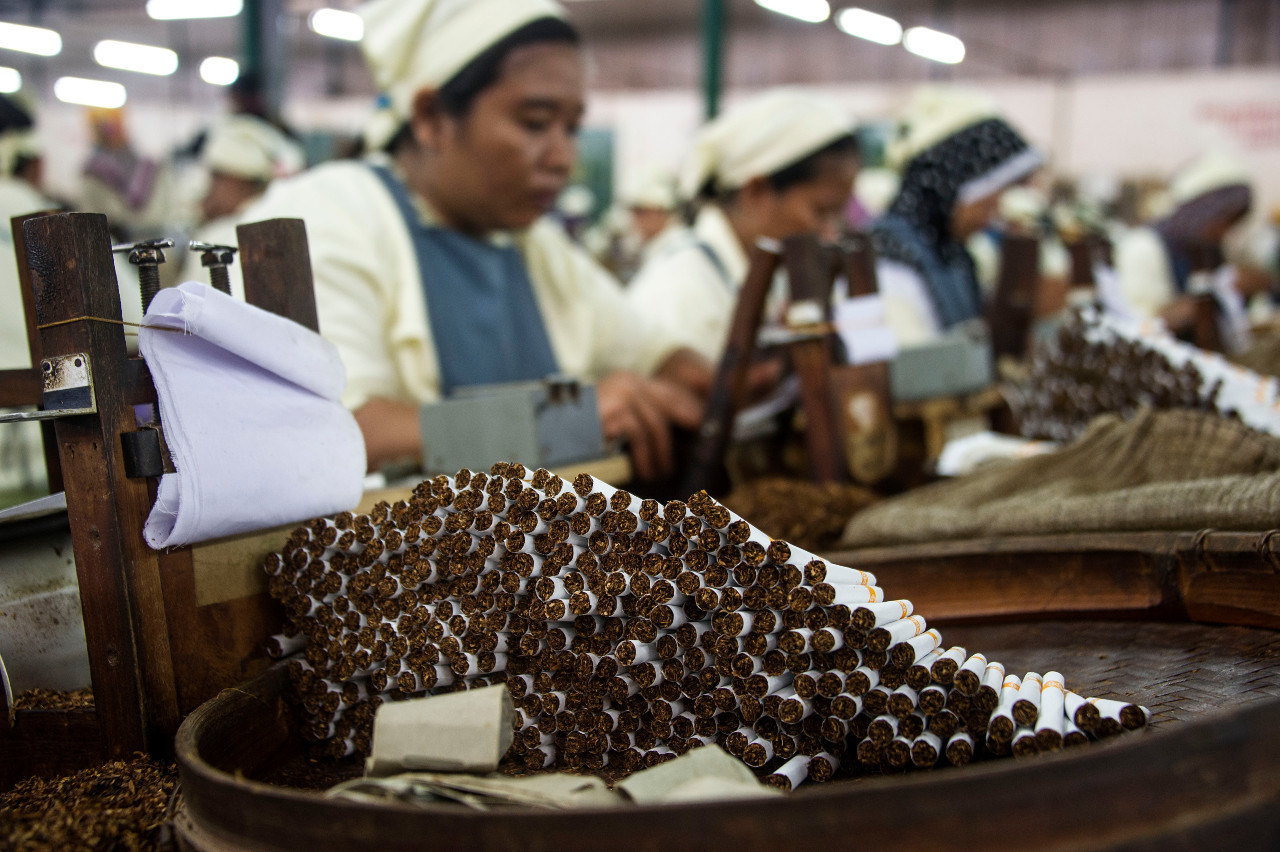Popular Reads
Top Results
Can't find what you're looking for?
View all search resultsPopular Reads
Top Results
Can't find what you're looking for?
View all search resultsCigarette excise tax, employment and industry income
Experience over the past years shows there is a negative correlation between cigarette price and sales, thereby smoking prevalence as well.
Change text size
Gift Premium Articles
to Anyone
T
he government has decided to raise the cigarette excise tax by 12.5 percent (weighted average) for 2021. Cigarette excise is a policy whose main objective is to reduce the consumption of cigarettes certainly with ramifications on the industry and employment, as well as illegal cigarette production.
The debate on whether excise should be applied almost does not exist as everybody agrees on the importance of lowering cigarette consumption. Based on the 2018 Indonesian Basic Health Survey, one out of three Indonesian adults smoke cigarettes. The prevalence rate in teenagers, aged 10-18, was rather high as well at 9.1 percent.
In the medium-term national development plan (RPJMN 2020-2024), it is stated that the figure should go down if we want to boost the quality of human resources. Specifically, smoking prevalence in school-aged children should be brought down to 8.7 percent in 2024. Therefore, the RPJMN states that the excise tax policy should be adjusted to meet the target.
Experience over the past years shows there is a negative correlation between cigarette price and sales, thereby smoking prevalence as well.
Due to the excise policy, cigarette prices alongside associated taxes in Indonesia are now higher than the average in upper-middle-income countries by international dollars at purchasing power parity (PPP), although still a lot lower than high-income countries. Add the fact that the World Health Organization encourages an increase in excise tax so that all tobacco taxes account for at least 70 percent of retail prices for tobacco products, all these means that there is still room for a cigarette excise increase in the future to bring down the prevalence rate.
From the production side, it is pretty clear that cigarette sales overall will be negatively impacted. However, the impact varies across the type of cigarettes. In 2020, based on cigarette sales data as of Oct. 31, machine-made white (pure tobacco) cigarettes, which dominate the market share, saw a high fall of approximately 30.5 percent. Interestingly, the sales of much cheaper hand-rolled cigarettes increased by 14.7 percent.
On the other hand, the income of the cigarette industry was stable due to the industry’s ability to mitigate the price increase. The industry was dominated by seven big companies accounting for 79 percent of the total market share (2019). Gudang Garam, for example, enjoyed a rise in its profit margin from 8.8 percent in 2016 to 9.8 percent in 2019.
The kretek (clove-tobacco blended) cigarette industry employs 158,552 workers, while clove and tobacco farmers make up 526,000 workers. The industry by units is also dominated by small producers of kretek cigarettes, with a total of around 480 small factories with a capacity of fewer than 500 million cigarettes per year. It is indeed important to look at how the excise actually affected these vulnerable people.
From the macro perspective, little did we know that the impact of the cigarette excise policy is not the main problem for the tobacco industry’s development. Despite the higher tax rate, local tobacco production saw a steady rise in 1980-2019 (Agriculture Ministry data). Local tobacco demand even increased from 127,000 tons to 197,000 tons in 2019, meaning there was no impact of the excise tariff increase throughout the period. The demand was even higher than the local supply, thereby necessitating imports.
A study by the University of Indonesia (2020) in some tobacco-producing areas such as Temanggung, Rembang and Magelang in Central Java, Pamekasan and Jember in East Java, and Lombok in West Nusa Tenggara, discovered that there are challenges on the micro side.
They could not operate optimally because of the high production cost such as fertilizer, the high risk of production due to weather uncertainty, long supply chains, as well as big factories dominating the market share of cigarettes in Indonesia — mostly eating up hand-rolled kretek cigarettes, whose market share is only 19.40 percent.
The 2021 excise policy accommodates this concern by exempting the excise tax increase from hand-rolled cigarettes and a relatively lower tariff increase in 2019. The policy helps to lessen the impact on consumption. The excise policy of 2021 also supports another fiscal policy instrument on revenue-sharing for cigarette tax revenues.
As stipulated in Finance Ministerial Regulation No. 7/2020, a proportion of excise revenue is transferred to the local governments of the producing areas and allocated for predetermined activities, such as social assistance to tobacco farmers and cigarette factory workers, as well as technical assistance and capital provision to farmers and workers turning small entrepreneurs; and input quality enhancement. The funds can also be appropriated as cash aid for impacted tobacco farming and cigarette workers.
Apart from fiscal policy, some real sector policies can be made to address the issue of the tobacco industry supply-side. The government can facilitate the partnership between cigarette manufacturers and tobacco farmers to match what the industry needs and what the farmers produce. Also, the government can improve the tobacco trading system and assist small tobacco farmers as they, in most cases, have a weak bargaining position against large cigarette companies.
All in all, we should admit that 2020 was a tough year for all industrial sectors in Indonesia. By increasing the tobacco excise tax by 12.5 percent, we estimate that this policy would further push cigarette sales to decrease by 2.2 percent. On the bright side, smoking prevalence would also go down at around 32.4 percent in adults and 8.9 percent in children.
***
The writers are analysts at the Finance Ministry’s Fiscal Policy Agency. The views expressed are their own.









